Knative Serving builds on Kubernetes and Istio to support deploying and serving of serverless applications and functions. Serving is easy to get started with and scales to support advanced scenarios.
Let's introduce how to quickly install Knative Serving and scale automatically based on Alibaba Cloud Container Service for Kubernetes
Alibaba Cloud Container Service supports the Kubernetes 1.12.6 now, making it easy to create Kubernetes clusters through the Container Service Management Console, see Create a Kubernetes cluster.
Knative depends on Istio for traffic routing and ingress. Currently, Alibaba Cloud Container Service Kubernetes has provided a quick one-click deployment to install and configure Istio, see the Deploy Istio.
Log on to the Container Service console. Under Kubernetes, click Clusters in the left-side navigation pane. On the right of the target cluster, choose More > Deploy Istio.

You can view your deployment results in the following way:
Application > Pods, select the cluster and namespace in which Istio is deployed, and you can see the relevant pods in which Istio is deployed.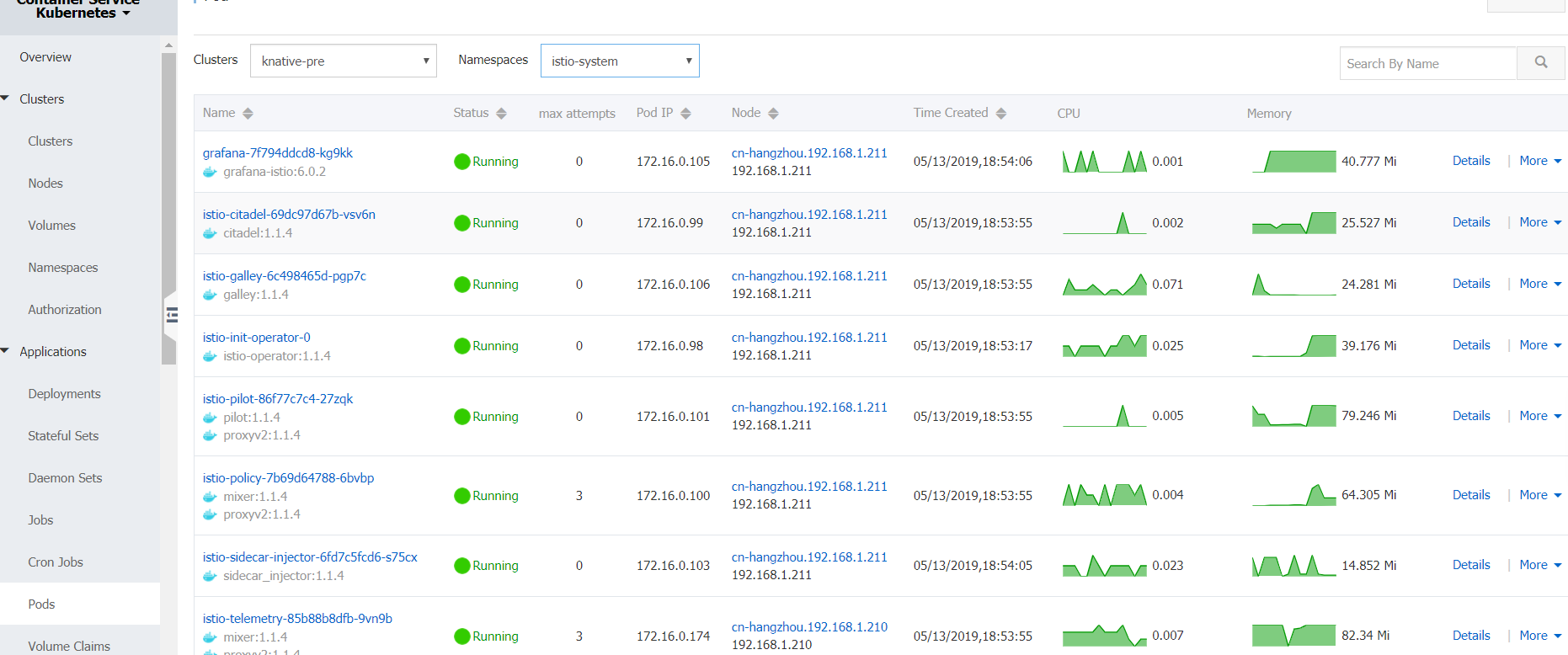
In the left-side navigation pane, choose Store > App Catalog. Click the ack-istio-ingressgateway.

Click the Values tab, and then set the parameters. You can set customized parameters, including indicating whether to enable a specific port, or whether to use the intranet SLB or the Internet SLB by setting the serviceAnnotations parameter.
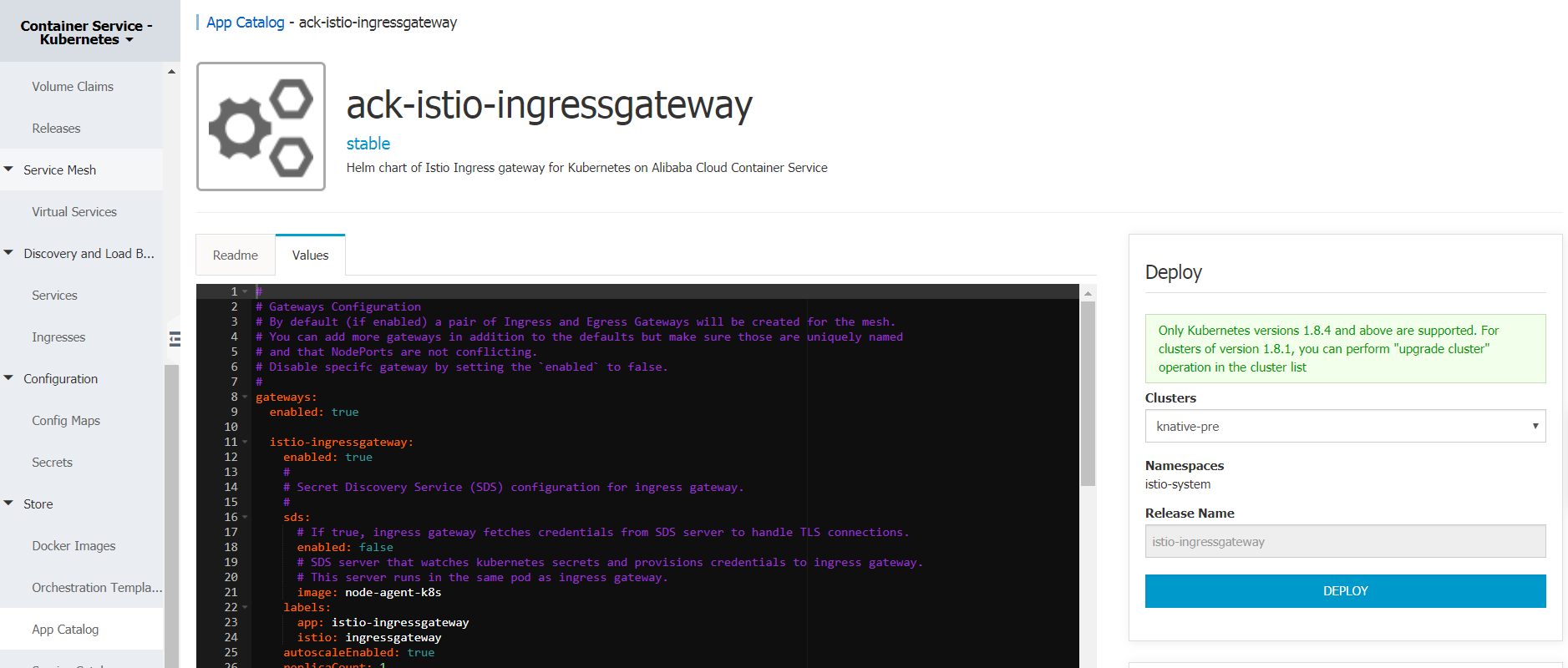
In the left-side navigation pane, choose Application > Pod. Select the target cluster and the istio-system namespace to view the pod to which the Istio Ingress gateway has been deployed.

Log on to the Container Service console. In the left-side navigation pane, choose Store > App Catalog. Click the ack-knative-init.
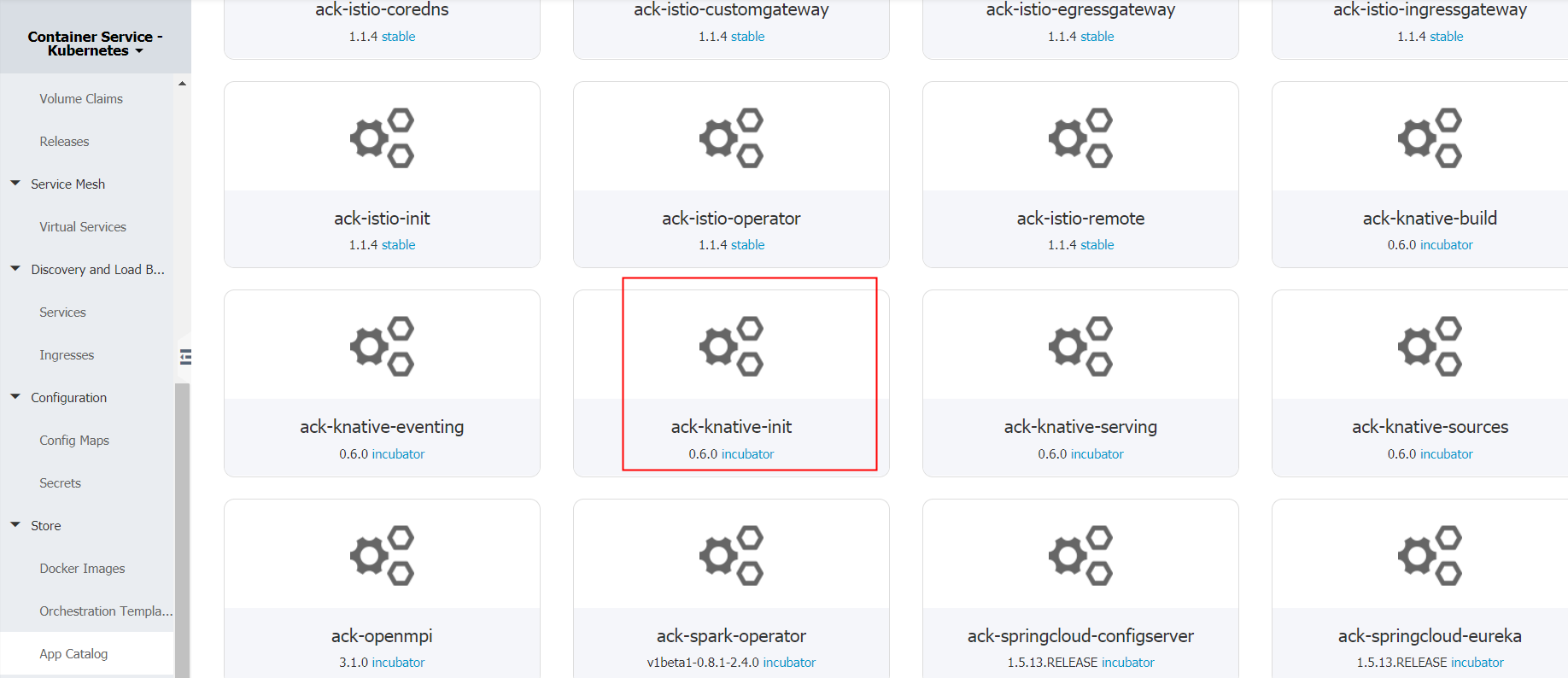
In the Deploy area on the right, select the target Cluster from the drop-down list, and then click DEPLOY.
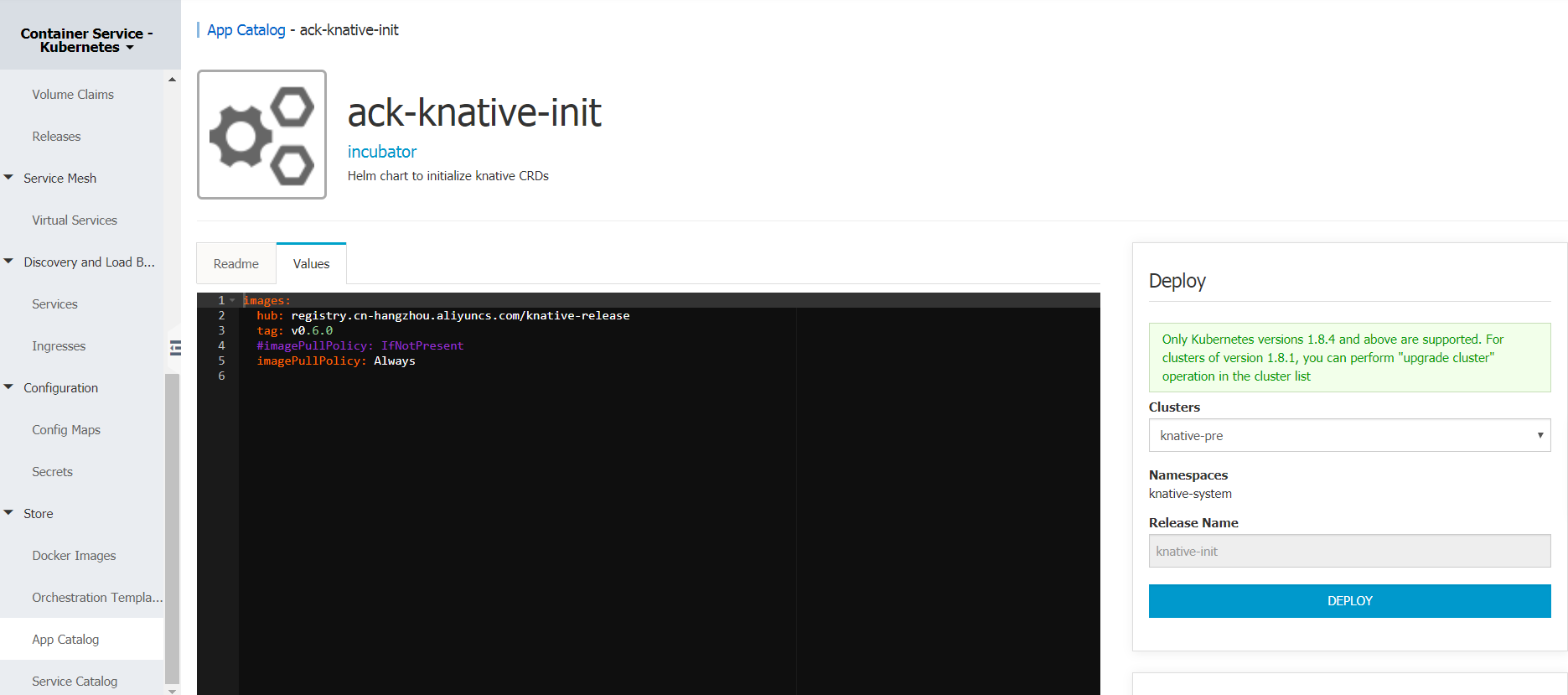
Log on to the Container Service console. In the left-side navigation pane, choose Store > App Catalog. Click the ack-knative-serving.
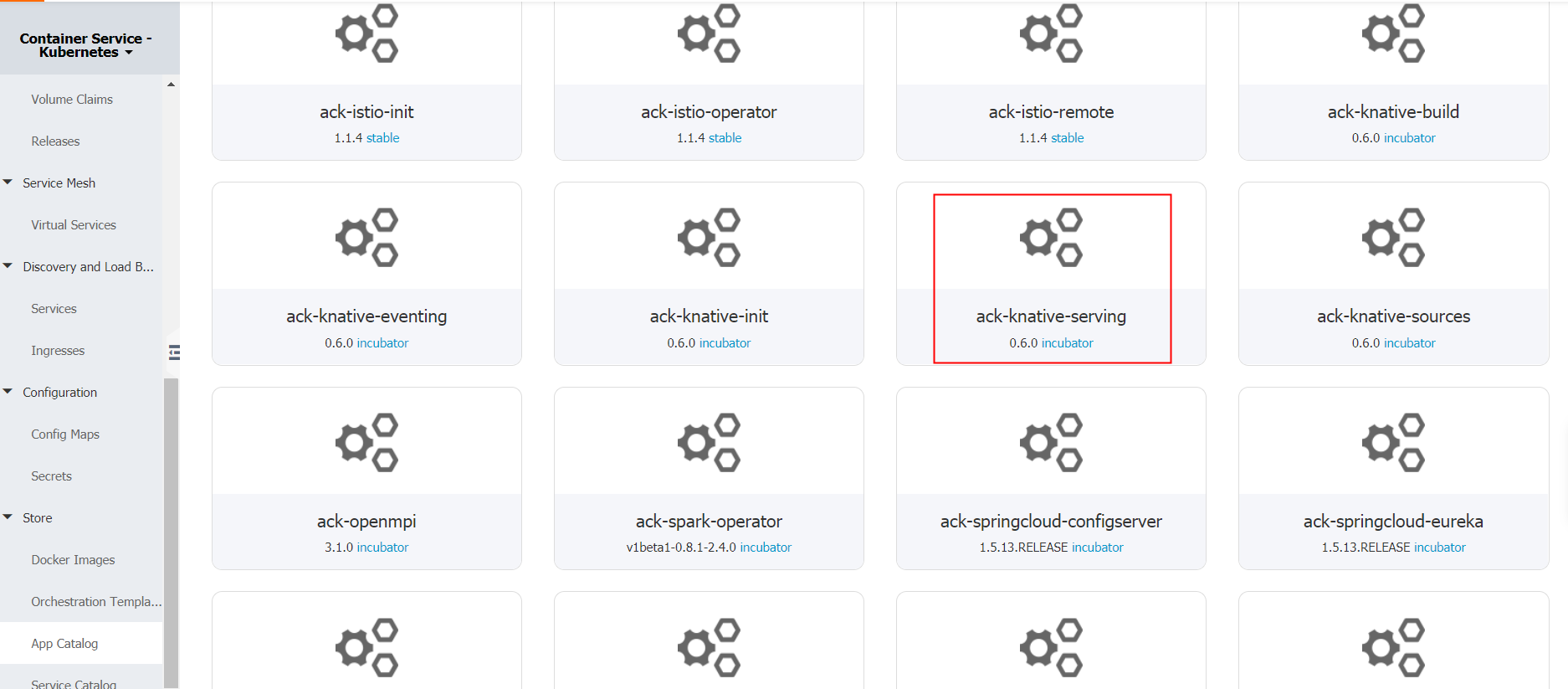
Click the Values tab, then set the parameters. You can set customized values for parameters, or use the default value Istio IngressGateway. And then click DEPLOY.
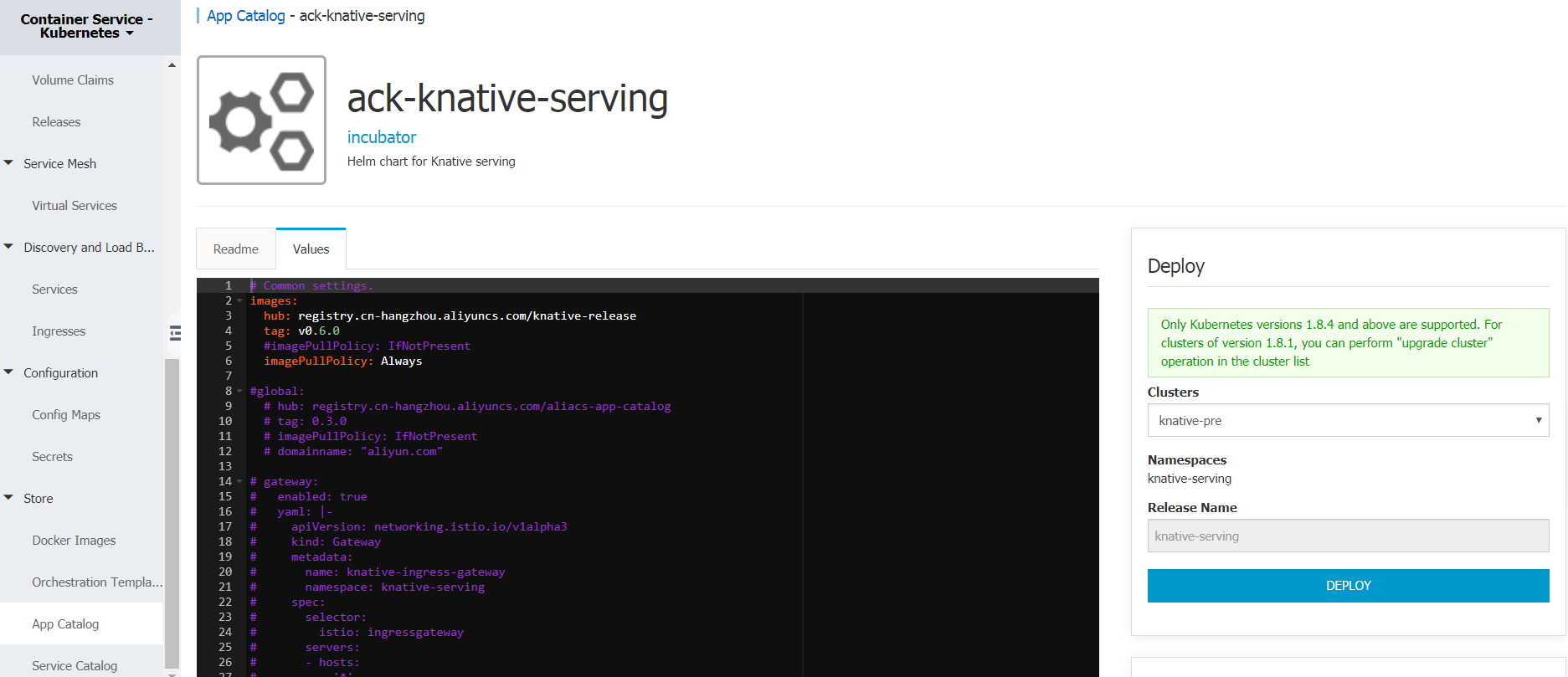
Currently, the all four Helm charts for the Knative serving have been installed. Like this:
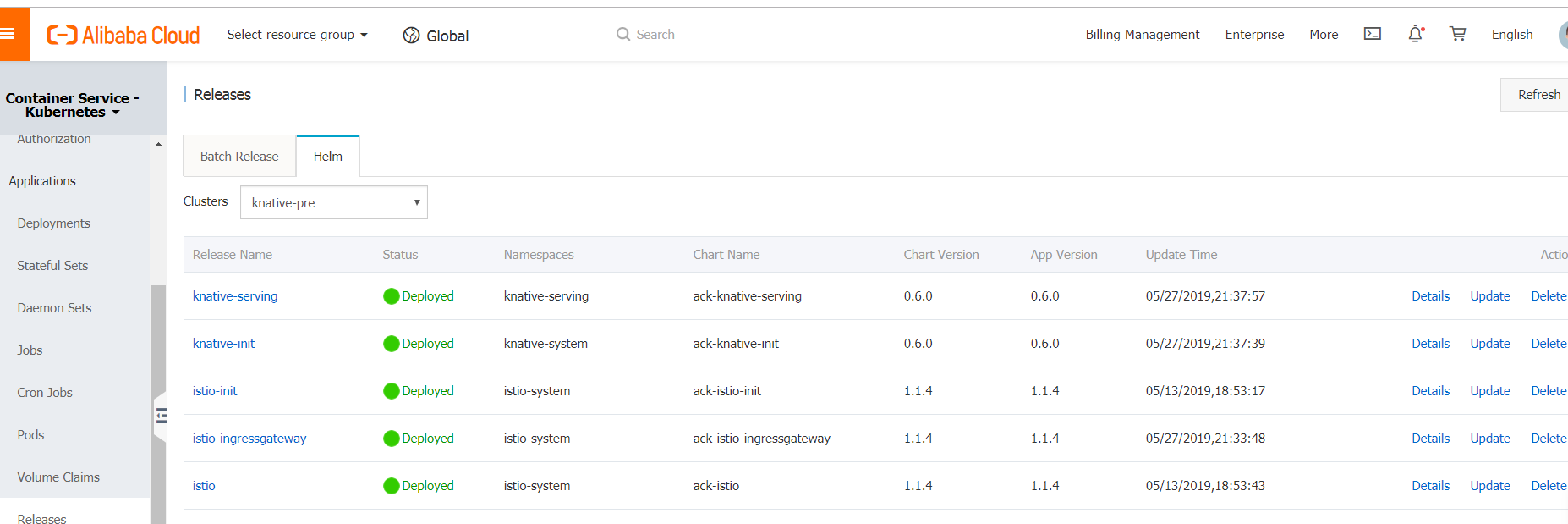
Deploy the sample Knative Service, run the following command:
kubectl create -f autoscale.yamlExample of the autoscale.yaml:
apiVersion: serving.knative.dev/v1alpha1
kind: Service
metadata:
name: autoscale-go
namespace: default
spec:
runLatest:
configuration:
revisionTemplate:
metadata:
annotations:
# Target 10 in-flight-requests per pod.
autoscaling.knative.dev/target: "10"
autoscaling.knative.dev/class: kpa.autoscaling.knative.dev
spec:
container:
image: registry.cn-beijing.aliyuncs.com/wangxining/autoscale-go:0.1Obtain both the hostname and IP address of the istio-ingressgateway service in the istio-system namespace, and then export them into the IP_ADDRESS environment variable.
export IP_ADDRESS=`kubectl get svc istio-ingressgateway --namespace istio-system --output jsonpath="{.status.loadBalancer.ingress[*].ip}"`Make a request to the autoscale app to see it consume some resources.
curl --header "Host: autoscale-go.default.{domain.name}" "http://${IP_ADDRESS?}?sleep=100&prime=10000&bloat=5"Note, need to replace the {domain.name} to your domain. The domain name of the sample is aliyun.com.
curl --header "Host: autoscale-go.default.aliyun.com" "http://${IP_ADDRESS?}?sleep=100&prime=10000&bloat=5"
Allocated 5 Mb of memory.
The largest prime less than 10000 is 9973.
Slept for 100.16 milliseconds.Installing the hey load generator:
go get -u github.com/rakyll/heySend 30 seconds of traffic maintaining 50 in-flight requests:
hey -z 30s -c 50 \
-host "autoscale-go.default.aliyun.com" \
"http://${IP_ADDRESS?}?sleep=100&prime=10000&bloat=5" \
&& kubectl get podsWith the traffic request running for 30 seconds, the Knative Serving scale automatically as the requests increasing.
Summary:
Total: 30.1126 secs
Slowest: 2.8528 secs
Fastest: 0.1066 secs
Average: 0.1216 secs
Requests/sec: 410.3270
Total data: 1235134 bytes
Size/request: 99 bytes
Response time histogram:
0.107 [1] |
0.381 [12305] |■■■■■■■■■■■■■■■■■■■■■■■■■■■■■■■■■■■■■■■■
0.656 [0] |
0.930 [0] |
1.205 [0] |
1.480 [0] |
1.754 [0] |
2.029 [0] |
2.304 [0] |
2.578 [27] |
2.853 [23] |
Latency distribution:
10% in 0.1089 secs
25% in 0.1096 secs
50% in 0.1107 secs
75% in 0.1122 secs
90% in 0.1148 secs
95% in 0.1178 secs
99% in 0.1318 secs
Details (average, fastest, slowest):
DNS+dialup: 0.0001 secs, 0.1066 secs, 2.8528 secs
DNS-lookup: 0.0000 secs, 0.0000 secs, 0.0000 secs
req write: 0.0000 secs, 0.0000 secs, 0.0023 secs
resp wait: 0.1214 secs, 0.1065 secs, 2.8356 secs
resp read: 0.0001 secs, 0.0000 secs, 0.0012 secs
Status code distribution:
[200] 12356 responses
NAME READY STATUS RESTARTS AGE
autoscale-go-00001-deployment-5fb497488b-2r76v 2/2 Running 0 29s
autoscale-go-00001-deployment-5fb497488b-6bshv 2/2 Running 0 2m
autoscale-go-00001-deployment-5fb497488b-fb2vb 2/2 Running 0 29s
autoscale-go-00001-deployment-5fb497488b-kbmmk 2/2 Running 0 29s
autoscale-go-00001-deployment-5fb497488b-l4j9q 1/2 Terminating 0 4m
autoscale-go-00001-deployment-5fb497488b-xfv8v 2/2 Running 0 29sBased on Alibaba Cloud's Container Service for Kubernetes, we can quickly install Knative Serving and scale automatically. Welcome to use the container service on Alibaba Cloud to install Knative and integrate it into your product.
Knowledge Sharing: Category-based Interpretation of Kubernetes v1.14 Release Notes
GPU Sharing Scheduler Extender Now Supports Fine-Grained Kubernetes Clusters

222 posts | 33 followers
FollowAlibaba Cloud Native Community - November 15, 2023
Alibaba Developer - February 3, 2020
Alibaba Container Service - July 19, 2021
Alibaba Container Service - September 14, 2022
Alibaba Container Service - June 16, 2020
Alibaba Container Service - July 22, 2024

222 posts | 33 followers
Follow Container Service for Kubernetes
Container Service for Kubernetes
Alibaba Cloud Container Service for Kubernetes is a fully managed cloud container management service that supports native Kubernetes and integrates with other Alibaba Cloud products.
Learn More ACK One
ACK One
Provides a control plane to allow users to manage Kubernetes clusters that run based on different infrastructure resources
Learn More Container Registry
Container Registry
A secure image hosting platform providing containerized image lifecycle management
Learn More Cloud-Native Applications Management Solution
Cloud-Native Applications Management Solution
Accelerate and secure the development, deployment, and management of containerized applications cost-effectively.
Learn MoreMore Posts by Alibaba Container Service